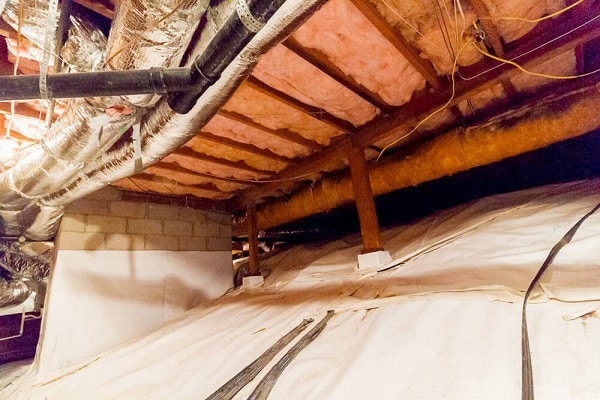If you walk around your house and look at the foundation walls, you’ll see metal screens with slats or a grid allowing air to flow through. These screens are vents for your home’s crawl space, and they are vital to the house’s maintenance and comfort. Proper ventilation of crawl spaces is crucial for preventing expensive structural damage to your home.
Importance of Crawl Space Ventilation
The crawl space is the area under a house between the ground and the underside of the first floor. If your crawl space isn’t well-ventilated, it can lead to many costly problems. Let’s discuss the basics of a vented crawl space, what you need to know, and the issues that can come from poor ventilation.
Crawl Space Problems Developed Over Time
Engineers developed ventilation in crawl spaces under houses and buildings to prevent the accumulation of moisture. Before this innovation, structures built for shelter had a much shorter life span. Moisture in your crawl space can lead to serious troubles, such as:
Mold and Mildew
Mold and mildew are terrible for your home. Mold is notoriously difficult to eliminate and leads to expensive and time-consuming problems. With minimal light and ventilation, mold issues will only worsen without prevention or restoration.
Crawl space moisture can cause mold to overtake floor cavity insulation and structural components. Having properly vented crawl spaces can keep mold and mildew from infiltrating your floors and walls and causing health issues in your home.
Rotting
Water causes wood rot to some structural elements beneath your house, and basement foundations do not respond well to prolonged exposure to moist air. Beams, floor joists, posts, flooring, and sills will break down and require replacement before areas of your home begin to collapse.
Pests
Animals are always looking for water, and your dark, enclosed crawl space is a cozy, safe place for them to nest. Animals that infiltrate your crawl space can cause structural damage or carry harmful bacteria or diseases. Crawl space moisture can attract all sorts of pests, including:
- Rats
- Mice
- Termites
- Snakes
- Skunks
- Carpenter ants
- Feral cats
- Roaches
- Spiders
Requirements for Crawl Space Ventilation Work
The International Residential Code (IRC) dictates all crawl space ventilation requirements unless state regulations supersede them.
Crawl Space Ventilation Calculation
IRC requires one square foot of screened vent space on the foundation perimeter for every 150 square feet of space in the crawl space. If your foundation measures 40 feet by 40 feet, you’ll need enough ventilation to cover eleven square feet.
If you install a vapor barrier in your crawl space over the soil, IRC only requires one square foot vent per 1,500 square feet of space. IRC also requires a ventilation opening near each corner of a house or building.
Each vent must be at least one square foot in size. Permitted materials for vents include:
- Sheet metal plates no less than 0.047 inches thick
- Perforated sheet metal plates 0.070 inches thick or more
- Cast-iron grating
- Load-bearing extruded brick vents
- Hardware cloth comprised of wire 0.035-inches or heavier
- Corrosion-resistant wire mesh at least 1/8-inch thick
If you install a vapor barrier in your crawl space, you can use vents with moveable slats.

Crawl Space Ventilation Process
The process of ventilating crawl spaces works in tandem with the temperature-controlled area of a house to reduce moisture.
- The HVAC system in your home mechanically circulates air through the living space while regulating temperature.
- To keep excess moisture from accumulating throughout the living space of a home, the attic and crawl space also need a method of air circulation.
- Crawl space vents create airflow under a house, allowing air to circulate naturally and keep fresh air present.
- Water in the soil that evaporates into the air now has a way to exit the crawl space.
- Crawl space insulation and the vapor barrier significantly minimize the amount of moisture in the air so the crawlspace vents can circulate and transport water vapor correctly.
Average Cost of Crawl Space Ventilation
Improper ventilation in your crawl space can lead to several different moisture-related problems. The longer the problem goes undiagnosed, the more expensive and extensive the repairs will be. The average cost of crawl space repair is $6,000, with repairs ranging from $1,500 to $15,000. Having a properly vented crawl space along with crawl space encapsulation can prevent moisture buildup, improve energy efficiency and maintain higher indoor air quality, making it an investment that is far better than the repair costs can be.
Attic Projects offers services to clean crawlspaces and spot trouble areas before they worsen.
Benefits of Crawl Space Ventilation
Benefits of having a vented crawl space or basement include:
Preventing Corrosion and Rust
Moisture causes metal to rust, and without proper crawl space ventilation, metal items like ductwork and HVAC components will begin to rust fast. Ventilation reduces such moisture, extending the life of metal appliances and other features in your crawl space. Removing moisture laden air through crawlspace and foundation vents protects not only the foundation walls but also mechanical equipment and fiberglass insulation.
Preventing Electrical Issues
The wiring in your crawl space should never get wet. Electrical components exposed to moisture can malfunction, catch fire, or shock you or other occupants of your home. Vented crawl spaces allow humid air to escape through the ventilation openings and protect advanced energy equipment.
Helpful Reading: Attic Crawl Space Doors
Frequently Asked Questions (FAQs) – The Crawl Space Ventilation
Does My Crawl Space Need Ventilation?
Yes. While some property owners choose to have closed crawlspace ventilation, crawl spaces need something to reduce moisture.
How Many Vents Should a Crawl Space Have?
Most building codes in the US follow the IRC crawl space ventilation formula; one square foot of vent space for every 150 square feet in the crawl space. Check with your municipality before you begin construction on a house or building.
Why Are Crawl Space Vents Closed During Winter?
Many property owners opt to close their crawl space vents in the winter to prevent pipes from freezing. This practice may keep your floors warm, but you also risk trapping moisture and inviting troubles down the line.
Do I Need a Ventilation Fan for My Crawl Space?
Ventilation fans, or circulation fans, are for crawl space mechanical ventilation. If your crawl space doesn’t already have fans, you probably don’t need them.
Conclusion
Crawl space ventilation systems save homeowners tons of headaches and steep repair bills. Attic Projects offers a wide variety of crawl space services, including cleanup, insulation replacement, and mold remediation. Call Attic Projects today to get a free quote, or contact our experienced and knowledgeable team online for any questions or concerns!




